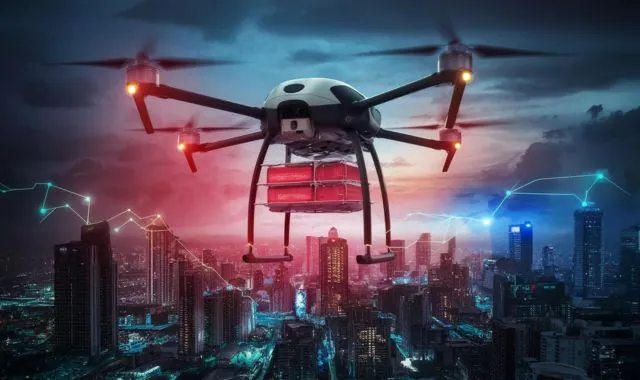Physical Address
304 North Cardinal St.
Dorchester Center, MA 02124

Drone Technology, or UAVs, have soared from military use to capturing stunning aerial footage and delivering goods. Explore how drones work, from various propulsion systems to flight control. We delve into their applications in recreation, agriculture, search and rescue, and more. The future holds promise with AI integration, clearer regulations, and the potential for urban air mobility. Drones are taking flight into a world of exciting possibilities.

Drones, also known as unmanned aerial vehicles (UAVs), have rapidly evolved from futuristic concepts to a ubiquitous technology shaping our world. From capturing breathtaking aerial footage to delivering vital supplies, drones are taking flight into a future filled with exciting possibilities.
Drones are flying machines that operate without a human pilot on board. They can be controlled remotely by a human operator using a joystick or pre-programmed to fly autonomously along a set path. Drones come in various sizes, from tiny palm-sized models to large, high-performance machines.
The concept of unmanned aerial vehicles dates back surprisingly far, with early designs emerging in the 19th century. However, the technology truly took off in the military sphere during the 20th century. Today, commercial and recreational applications are driving a new wave of innovation in the drone industry.
Drones are categorized based on their size, capabilities, and intended use. Common types include fixed-wing drones offering long flight times, multi-rotor drones known for their maneuverability, and specialized racing drones built for speed and agility.
Understanding the basic principles behind drone flight is fascinating.
Different Propulsion Systems: Drones rely on various propulsion systems to generate lift and navigate the skies. The most common type uses electric motors and propellers, while some larger drones utilize gasoline or jet engines.
Maintaining a stable flight path is crucial for drone operation. Drones achieve this through a combination of onboard sensors, gyroscopes, and accelerometers. These components feed data to a flight controller, which translates pilot commands or pre-programmed flight plans into adjustments for the motors and propellers.
Drones offer a wide range of applications across various sectors.
Drones have revolutionized aerial photography and videography, enabling breathtaking shots once achievable only with expensive helicopters or airplanes.
Drone racing has emerged as a popular sport, with pilots competing in high-speed courses filled with obstacles and gates.
Drone delivery is undergoing rapid development, with companies exploring the possibility of using drones to deliver packages quickly and efficiently.
Drones are transforming agriculture by allowing farmers to monitor crops, identify areas requiring attention, and even apply pesticides and fertilizers with greater precision.
Drones equipped with thermal imaging cameras are invaluable tools for search and rescue operations, helping locate missing persons in difficult terrain or harsh weather conditions.

Drones can be used to inspect buildings, bridges, and other infrastructure for damage or safety hazards, reducing risks for human inspectors.
As drone technology continues to evolve, we can expect to see significant advancements in several key areas.
Regulations are being developed to address concerns about airspace safety and privacy. As regulations become clearer, drone use is expected to become more widespread.
The integration of artificial intelligence (AI) will enable drones to perform tasks with greater autonomy and intelligence. Imagine drones that can navigate complex environments, avoid obstacles, and make real-time decisions.
The concept of urban air mobility (UAM) envisions a future where drones are used for passenger transportation within cities. While this technology is still in its early stages, it has the potential to revolutionize urban transportation.

In conclusion, drone technology has come a long way from its military origins. Today, drones are making a positive impact on various sectors, from delivering vital supplies to capturing stunning aerial visuals. As we look towards the horizon, the future of drones is brimming with exciting possibilities. With advancements in AI, clearer regulations, and the potential of urban air mobility, drones are poised to take flight and redefine how we interact with the world. The possibilities are truly endless, and the sky is no longer the limit!
The ease of flying a drone depends on the model. Smaller recreational drones are typically easy to learn, while larger, more complex drones require more practice and skill. Many drones offer flight assist features to make piloting smoother, especially for beginners.
Drones come in a wide range of price points, from affordable beginner models for under $100 to high-end professional drones costing tens of thousands of dollars. The price typically depends on the size, features, and capabilities of the drone.
Drone regulations vary depending on your location. It’s crucial to check the regulations in your area before flying a drone. Most countries have designated no-fly zones, and some require permits for specific types of drone use. A good starting point to find regulations is your local aviation authority website.
Drones can be safe when operated responsibly and following regulations. Always be aware of your surroundings, maintain a safe distance from people and property, and avoid flying in restricted airspace.
Privacy is a valid concern with drone use. It’s important to be respectful of others’ privacy and avoid flying drones over private property without permission. Many countries have regulations regarding drone use near residential areas and public gatherings.